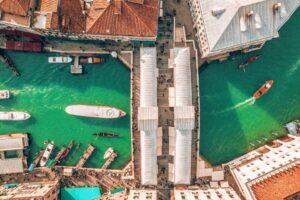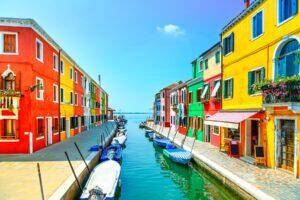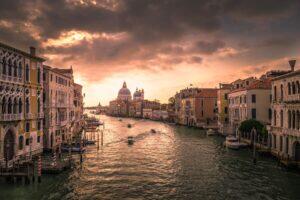Fodor's Expert Review Piazza San Marco
One of the world's most beautiful squares, Piazza San Marco (St. Mark's Square) is the spiritual and artistic heart of Venice, a vast open space bordered by an orderly procession of arcades marching toward the fairy-tale cupolas and marble lacework of the Basilica di San Marco. From midmorning on, it is generally packed with tourists. (If Venetians have business in the piazza, they try to conduct it in the early morning, before the crowds swell.) At night the piazza can be magical, especially in winter, when mists swirl around the lampposts and the campanile.
Facing the basilica, on your left, the long, arcaded building is the Procuratie Vecchie, renovated to its present form in 1514 as offices and residences for the powerful procurators, or magistrates.
On your right is the Procuratie Nuove, built half a century later in a more imposing, classical style. It was originally planned by Venice's great Renaissance architect Jacopo Sansovino (1486–1570), to carry on the look... READ MORE
One of the world's most beautiful squares, Piazza San Marco (St. Mark's Square) is the spiritual and artistic heart of Venice, a vast open space bordered by an orderly procession of arcades marching toward the fairy-tale cupolas and marble lacework of the Basilica di San Marco. From midmorning on, it is generally packed with tourists. (If Venetians have business in the piazza, they try to conduct it in the early morning, before the crowds swell.) At night the piazza can be magical, especially in winter, when mists swirl around the lampposts and the campanile.
Facing the basilica, on your left, the long, arcaded building is the Procuratie Vecchie, renovated to its present form in 1514 as offices and residences for the powerful procurators, or magistrates.
On your right is the Procuratie Nuove, built half a century later in a more imposing, classical style. It was originally planned by Venice's great Renaissance architect Jacopo Sansovino (1486–1570), to carry on the look of his Libreria Sansoviniana (Sansovinian Library), but he died before construction on the Nuove had begun. Vincenzo Scamozzi (circa 1552–1616), a pupil of Andrea Palladio (1508–80), completed the design and construction. Still later, the Procuratie Nuove was modified by architect Baldassare Longhena (1598–1682), one of Venice's Baroque masters.
When Napoléon (1769–1821) entered Venice with his troops in 1797, he expressed his admiration for the piazza and promptly gave orders to alter it. His architects demolished a church with a Sansovino facade in order to build the Ala Napoleonica (Napoleonic Wing), or Fabbrica Nuova (New Building), which linked the two 16th-century procuratie and effectively enclosed the piazza.
Piazzetta San Marco is the "little square" leading from Piazza San Marco to the waters of Bacino San Marco (St. Mark's Basin); its molo (landing) once served as the grand entrance to the Republic. Two imposing columns tower above the waterfront. One is topped by the winged lion, a traditional emblem of St. Mark that became the symbol of Venice itself; the other supports St. Theodore, the city's first patron, along with his dragon. (A third column fell off its barge and ended up in the bacino before it could be placed alongside the others.) Although the columns are a glorious vision today, the Republic traditionally executed convicts here—and some superstitious Venetians still avoid walking between them.
READ LESS








